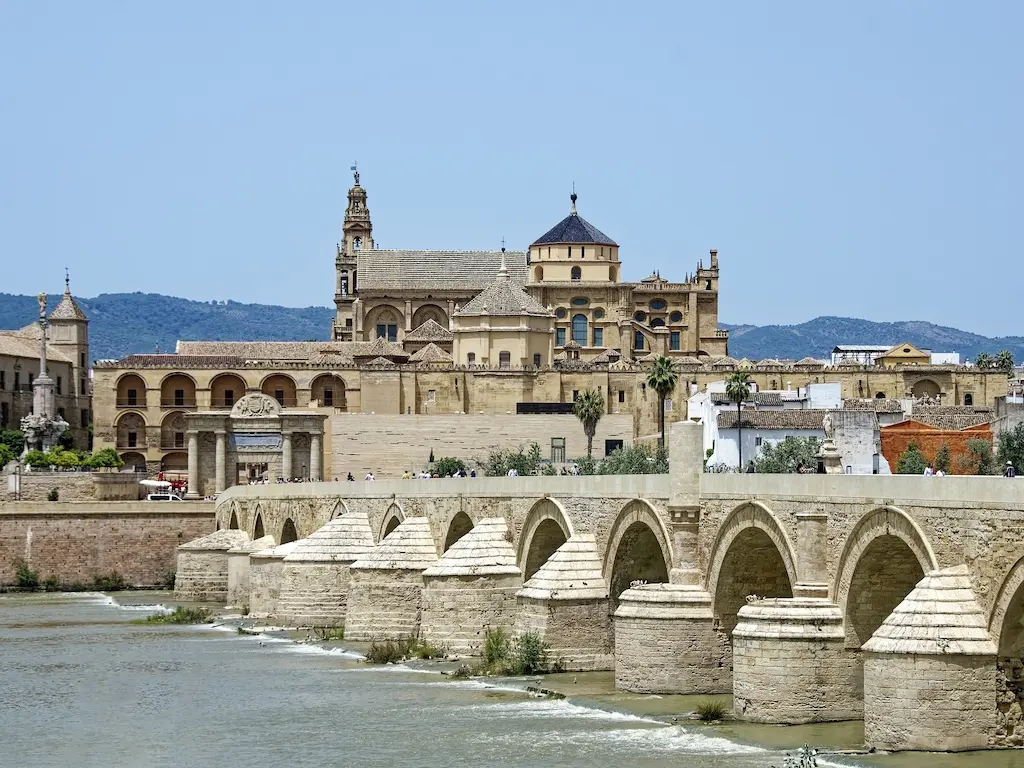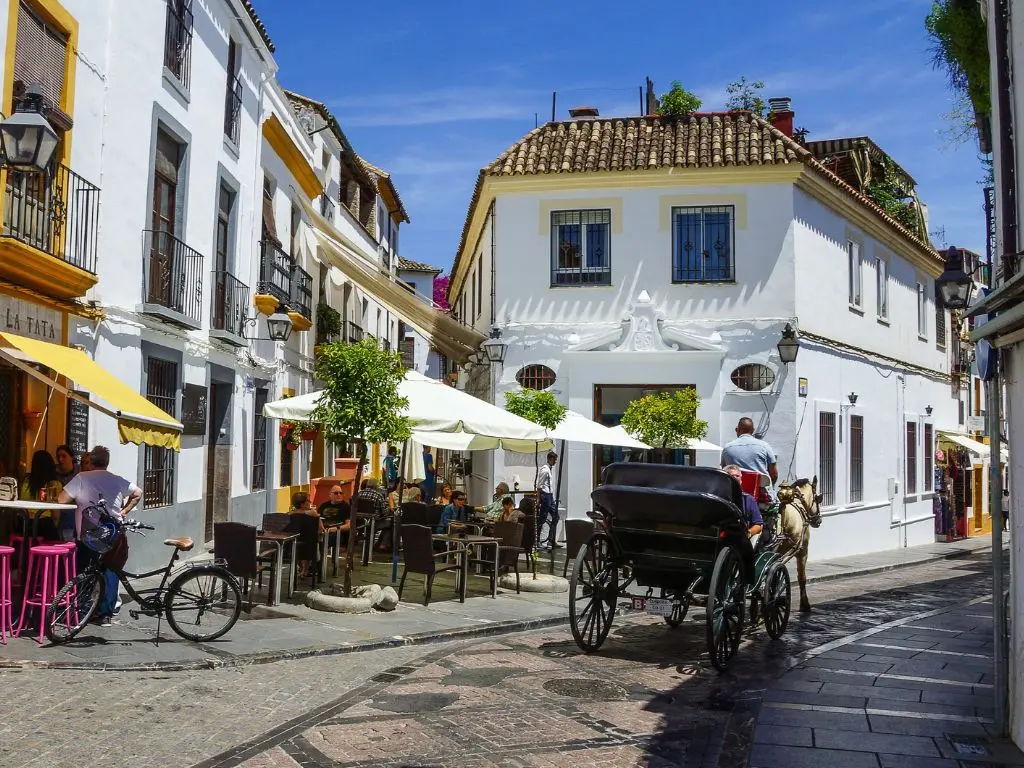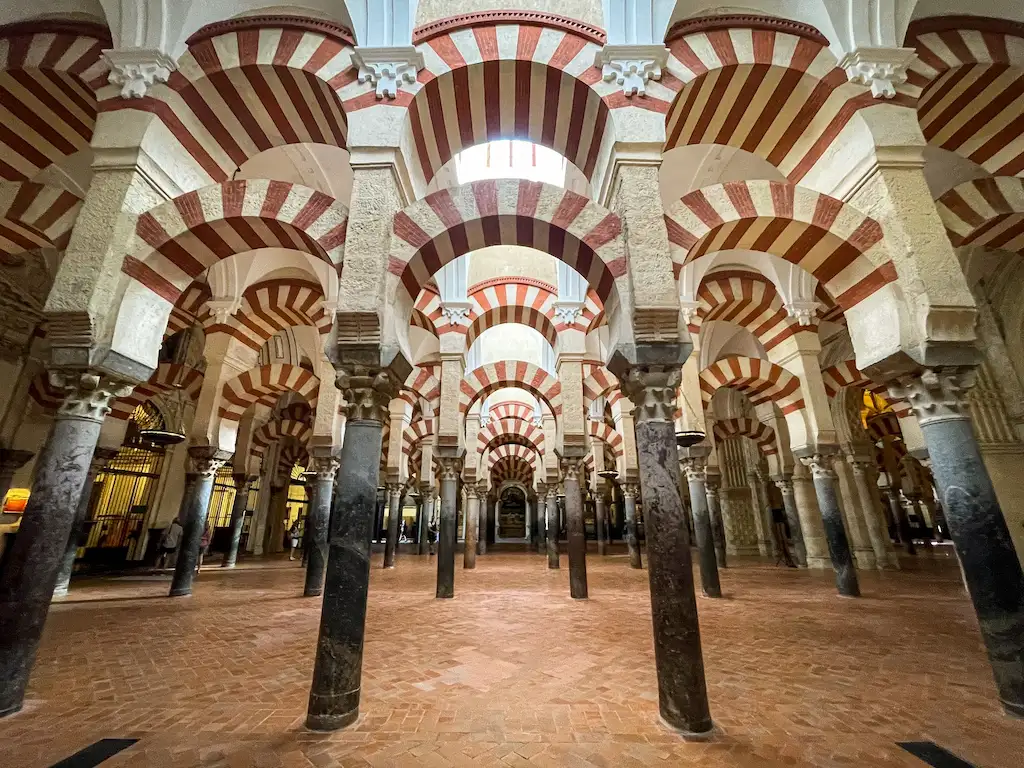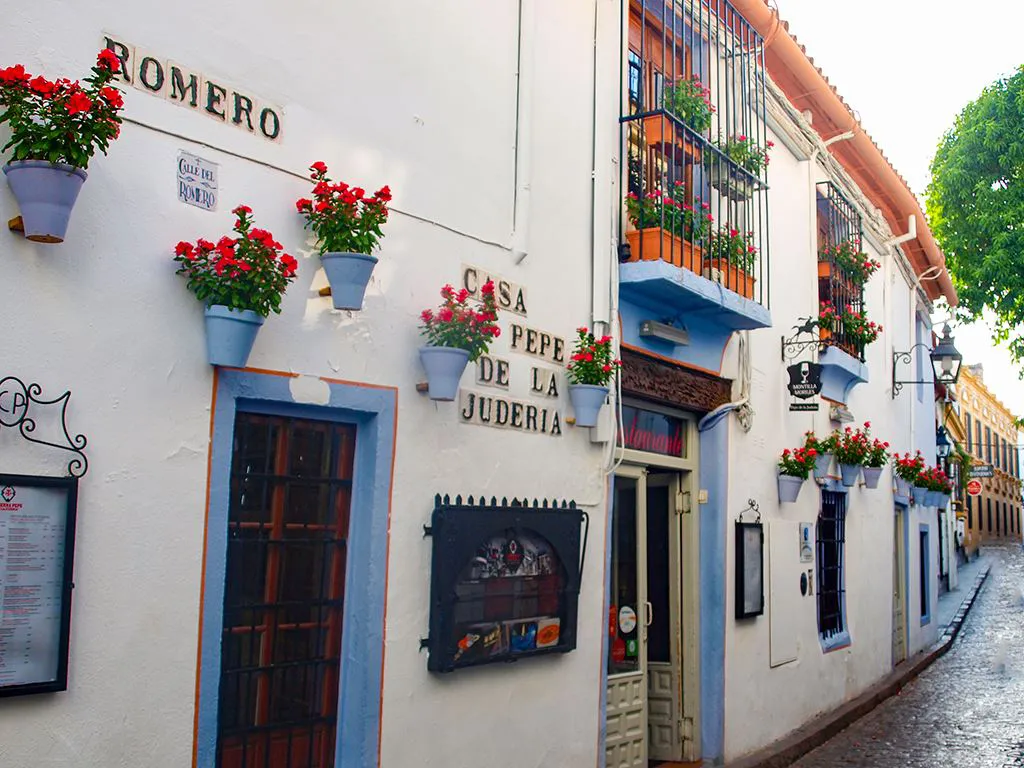Your ultimate guide to an unforgettable day trip in Cordoba, a gem in the heart of Andalucia. Here's everything you need to know to spend one day in Cordoba.
By Liza S. | Updated 12 Jan 2024 | Córdoba | Cities |
Login to add to YOUR Favourites or Read Later


Roman Bridge in Cordoba
Welcome to your guide to an unforgettable day trip in Cordoba, a gem in the heart of Andalucia. Once the largest city in the world, it was a centre of education and learning under the Moors and remains an emblem of cultural harmony. This guide aims to unwrap the magic of Cordoba in a day – a challenge, certainly, but an exhilarating one.
In this 1-day Cordoba itinerary, you’ll discover the city's must-see attractions, from the breathtaking Mezquita-Catedral, a masterpiece of Islamic architecture, to the charming streets of the Jewish Quarter. We'll also dive into the best local spots for authentic Cordoban dishes, and share tips on experiencing the city's lively culture and entertainment.
Designed to maximise your one day in Cordoba, you’ll get practical advice on getting around, what to expect at each site, and how to soak in the local atmosphere. Whether you have a full day or just a few hours, we'll help you make the most of your visit.
So, let's embark on a journey to experience the best of Cordoba in just one day!
Cordoba is a city brimming with history and charm, and ideally, it deserves more than just a day. But sometimes, that's all the time we have.
So, is one day enough to experience Cordoba? Well, yes and no.
In just one day, you can certainly capture the essence of Cordoba. The city's main attractions like the mesmerising Mezquita-Catedral, the quaint Jewish Quarter, and the historic Alcázar de los Reyes Cristianos are all within walking distance of each other. This means you can soak in their historic beauty without rushing from one place to another.
And let's not forget about the food – Cordoba's culinary scene is a delight, and even in a day, you can treat yourself to some authentic local dishes.
However, it's also true that a day trip only scratches the surface. Cordoba has those quiet, tucked-away corners that speak volumes about its past, leisurely cafe culture, and scenic walks that just can't be rushed. These experiences often require more than a day to truly appreciate. But hey, if a day is all you've got, let's make it count!
Start early to beat the crowds and end late to catch the beautiful Andalusian sunset. Plan your route but leave a little room for spontaneous discoveries. And remember, Cordoba at a quick pace can still be a magical experience – it's about immersing yourself in the moment, capturing the sights, the sounds, and the flavours, even if it's just for a day.
On my first visit to Cordoba, I only had one day to enjoy the city. It was a busy day, trying to experience as much as possible, but I was certainly able to hit the city’s highlights and get a taste of its charms.
And if you fall in love with Cordoba, you can always come back… like I did!


The historic centre of Cordoba
Making a day trip to Cordoba works best if you have a base in Andalucia as the city is well-connected to other cities in the region.
The majority of visitors spend one day in Cordoba as part of their stay in Seville but it’s also possible to day trip to Cordoba from Granada and Malaga. And, of course, if you’re doing a road trip through Andalucia, it’s easy to fit in a day in Cordoba in your itinerary.
Another option is to spend one day in Cordoba, if you’re arriving from Madrid. Thanks to the high-speed AVE train connection, it takes under 2 hours to travel from Madrid to Cordoba.
Here’s what you need to know on how to get to Cordoba.
I highly recommend using the train to get to Cordoba for your day trip. Thanks to the high-speed trains, the journey is fast and comfortable, giving you more sightseeing time in the city.
The high-speed AVE train connects Seville to Cordoba in approximately 45 minutes. Trains run frequently throughout the day, making it an ideal option for day-trippers. From Madrid, the AVE train takes about 1 hour and 45 minutes.
There are also train connections from Malaga (under 1 hour) and Granada (under 2 hours).
For a day trip to Cordoba, it’s best to start your day early. The morning trains to Cordoba tend to be popular so I suggest booking your tickets in advance to get the best fares and secure your spots. Prices vary, but booking in advance can often secure you a better deal.
Buses are a more economical option, though they take longer. From Seville, the journey is about 2 hours, and from Madrid, it can take upwards of 4 hours.
For a day trip to Cordoba, I recommend against taking the bus, unless you’re coming from a smaller town that doesn’t have a train connection to Cordoba. The train journey is much faster which gives you more time in Cordoba to enjoy the day.
Major bus companies like ALSA operate on these routes to Cordoba, and tickets can be bought online or at bus stations.
It’s a good idea to compare prices, schedules, and travel times when deciding the best way to get to Cordoba. Using Omio is an easy way to compare different modes of transport and prices in one place.
Simply input your travel dates below to compare.
Driving to Cordoba offers flexibility and the chance to enjoy the scenic Andalucian countryside.
From Seville, the drive takes about 1.5 hours via the A-4 motorway. The journey is around 1 hour 45 minutes from Malaga and about 2 hours from Granada. From Madrid, expect a journey of around 4 hours along the A-4.
Parking can be found around the city, though it's recommended to use a car park for convenience and safety. I also recommend parking outside of the historic centre as that area can be congested and it’s difficult to navigate.
Upon arriving in Cordoba, the city centre is easily navigable on foot. The main attractions are centrally located, making them easily accessible.
For those preferring not to walk, there are taxis and a reliable local bus service to get to/from the train or bus stations. On a day trip, you’ll most likely only need Bus #3 which runs between the train/bus station and the historic centre.
On a one-day visit to Cordoba, there are three top attractions that should be on any visitors’ list: the Mezquita, the Jewish Quarter, and the Alcazar de los Reyes Cristianos.
This suggested one-day Cordoba itinerary includes those three highlights as well as a few other beautiful spots that you may be interested in seeing along the way. If you have less than 6 hours in Cordoba, I suggest prioritising the top 3 sites I mentioned so that you’ll see the best of the city.
You may also want to consider this guided tour of the Mezquita, Jewish Quarter and the Alcazar where you can visit those sites with a local guide in just 4 hours!
Now let's get into what to do on your Cordoba day trip.


The interior of the Cordoba Mosque-Cathedral
Your day in Cordoba should rightfully begin at its most iconic landmark, the Mezquita-Catedral.
Most day-trippers to Cordoba come only to visit the Mezquita… and for good reason! In my opinion, this UNESCO World Heritage Site is a one-of-a-kind monument that you won’t find anywhere else in the world.
The Mezquita-Catedral of Cordoba is an awe-inspiring architectural marvel that stands as a magnificent symbol of the city's layered history. Originally constructed as a mosque in the 8th century under the Umayyad Caliphate, it was one of the grandest in the Islamic world.
Following the Reconquista in the 13th century, it was converted into a cathedral, with Christian elements added over the centuries. This harmonious blend of Islamic and Christian art and architecture makes it a unique symbol of the cultural and religious history of Spain.
Highlights of the Mezquita include the stunning Mihrab, an ornate prayer niche, and the expansive hall with its iconic double arches and columns made from jasper, onyx, marble, and granite. The cathedral's altar and choir, added after the Reconquista, are equally breathtaking with their Renaissance and Baroque influences.
On a day trip to Cordoba, I highly recommend buying your Mezquita tickets in advance to secure your entry and avoid waiting in line. And while you can enjoy this monument on an independent visit, you get so much more out of it when you join a guided tour!
I did a DIY visit my first time and a guided tour on my second visit and I definitely learned so much more with a local guide sharing the history of the building and pointing out architectural details. Plus, a guided Mezquita visit typically takes 60 to 90 minutes and covers the highlights of the Mezquita, making it both informative and time-efficient on a day trip.
There’s also a bell tower in the Mezquita, and there’s a separate ticket for that. While it’s nice to visit, I wouldn’t consider it essential if you have limited time in Cordoba.
Insider Tip: If you’re an early bird, the Mezquita is free to enter from 8:30 am to 9.30am (Monday to Saturday). It’s a lovely time to experience the tranquillity of the place without the crowds that descend later in the day.
Behind the grandeur of the Mezquita lies the Roman Bridge, a historical marvel that has been a cornerstone of Cordoba since the 1st century BC. For centuries, this bridge was the sole crossing over the Guadalquivir River, playing a crucial role in the city's connectivity and development.
The bridge's origins trace back to the Roman era, likely forming a segment of the Via Augusta - the extensive road network linking Rome to Cadiz in southern Andalucia. Its strategic importance was recognised and utilised by subsequent rulers, notably the Arabs, who reconstructed and expanded upon the Roman foundations.
The bridge's mediaeval character is accentuated by the two towers framing it: the Calahorra Tower at one end and the Puerta del Puente at the other, both adding a defensive and majestic aura to the structure.
Now a pedestrian-only pathway, the Roman Bridge offers a tangible connection to the past. Walking across it is like traversing the footpaths of Romans and Moors.
And for visitors to Cordoba, the bridge presents an unparalleled view of the city, especially looking back towards the Mezquita and the historic centre. Be sure to look back and snap some postcard-perfect images of Cordoba!

La Juderia in Cordoba is a UNESCO World Heritage Site
A short walk from the Mezquita and the Roman Bridge takes you to the Jewish Quarter, a labyrinth of narrow lanes and white-washed houses that form the heart of Cordoba's mediaeval history. Along with the Mezquita, Cordoba’s Juderia is also a UNESCO World Heritage Site.
The Judería is a poignant reminder of the Jewish community that flourished here during the Middle Ages, contributing significantly to the city's intellectual and cultural life until their expulsion in 1492.
As you wander around this historic neighbourhood, you'll find the Synagogue, one of Spain's only three pre-expulsion synagogues, a small but significant structure showcasing Mudéjar architecture.
Nearby, the Callejon de las Flores offers a picturesque snapshot of Andalucian charm, famous for its narrow passageway framed by flower-filled balconies and pots, leading to a stunning view of the Mezquita's bell tower.
La Juderia is also dotted with shops selling unique local crafts – perfect for picking up souvenirs to remember your Cordoba day trip. Consider stopping by the Zoco Municipal which houses artisan stores in a beautiful Cordoban courtyard.
After a morning steeped in history, midday in Cordoba presents the perfect opportunity to explore its cuisine. Cordoba's gastronomy is a delightful blend of traditional Andalucian flavours with Moorish influences, offering a range of dishes that are both flavorful and unique.
No visit to Cordoba is complete without indulging in its famous tapas. The city's bars and restaurants serve up a variety of small, delicious plates perfect for sampling local flavours.
Key dishes to try include:
For an authentic Cordoban dining experience, here are our restaurant recommendations:
After lunch, make your way to the final must-see spot on your day trip to Cordoba: Alcázar de los Reyes Cristianos.
This fortress-palace, once the residence of Christian kings, is a remarkable blend of military architecture and lush gardens. Its history is a blend of Roman, Visigothic, Moorish, and Christian influences, making it a fascinating chronicle of Cordoba's past. The Alcázar played a significant role in the Reconquista and was later used by the Catholic Monarchs, Ferdinand and Isabella, in their campaign against the Moors.
While the interior of the palace isn’t anywhere as luxurious or impressive as others in Andalucia, the true highlight of the Alcázar de los Reyes Cristianos is its gorgeous gardens. Lush, green, and intricately designed, the palace gardens are a serene escape, with fountains and ponds adding to their charm.
Plus, the late afternoon light provides a magical glow to the gardens, perfect for photography!
Tickets for the Alcazar are only available on-site and sometimes, there can be a long line to enter. In my experience, the line typically moves quickly but if you’re short on time and the queue is too long, it might not be worth the wait.
You can also consider taking a guided tour of the Alcazar which includes skip-the-line tickets.
Cordoba is famed for its patios, a vibrant expression of local living where flowers and greenery are displayed in private courtyards. These hidden gems come to life, especially during the annual Patio Festival in May, but you can see glimpses of this beautiful tradition year-round.
The Zoco Municipal in the Jewish Quarter is one patio that’s open and available all-year-round. And while you’re wandering around La Juderia, I recommend keeping an eye for any open doorways where you can peek into a patio.
The San Basilio neighbourhood around the Alcazar is also well-known for having some of the most beautiful and well-preserved patios in the city. So if time permits, take a stroll around the neighbourhood and admire the patios!
Visit this website to learn more about Cordoba’s patios and where to find them.
If you have more time or if you choose not to visit the Alcazar de los Reyes Cristianos, then consider a visit to Palacio de Viana.
Known as the 'Museum of the Patios', this 14th-century palace is a testament to Cordoba's famous courtyard culture, boasting 12 distinct patios, each with its own unique character and botanical beauty.
Originally belonging to the aristocratic Marquises of Viana, the palace has evolved over centuries, with each generation adding their own architectural and horticultural touches. Palacio de Viana offers a glimpse into the lavish lifestyle of the Spanish nobility and also exemplifies the importance of courtyards in Cordoban architecture.
The palace itself houses a collection of art, tapestries, and antique furniture but the real treasures here are the patios. Each courtyard in Palacio de Viana tells a different story, with varying themes from Roman to Renaissance, showcasing a range of plants, fountains, and intricate tile work.
When I visited Palacio de Viana, I didn’t know what to expect and I ended up really enjoying their different courtyards and seeing such a vital tradition of Cordoba.
Palacio de Viana is located in the northern part of the city and it’s about a 20-25 minute walk from the historic centre. While it is a pleasant walk, I suggest taking a taxi or Uber to get there so that you save some travel time.
You can buy tickets for Palacio de Viana here.
Whether you need a quick bite before your journey back or if you’re having dinner in Cordoba, a visit to Mercado Victoria is the perfect way to end your one day in Cordoba on a high note.
Situated in a beautifully restored 19th-century wrought-iron pavilion, Mercado Victoria is Cordoba's first gourmet market and a bustling hub of gastronomic delights. This vibrant food market encapsulates the spirit of Cordoba’s diverse cuisine, offering a wide array of options ranging from traditional Andalucian tapas to international dishes.
Within its lively atmosphere, you'll find over 30 stalls, each offering its unique take on culinary art. Sample classic Cordoban fare like salmorejo or venture into contemporary fusion dishes. Besides the food stalls, there are bars serving local wines and craft beers, perfect for pairing with your chosen delicacies.
Its open-air seating and relaxed ambiance provide a delightful setting to reflect on your day's adventures in Cordoba, enjoying the flavours of the city under the Andalucian sky.
While it’s easy to visit Cordoba on a day trip independently, if you prefer to have a hassle-free visit, a guided day trip to Cordoba can be a great way to see the city’s highlights without having to do any planning.
Check out these guided day trips to Cordoba from various cities in Andalucia:
Here are some travel tips to make the most of your Cordoba day trip.
I hope you’ve found this guide helpful in helping you plan an amazing one-day visit to Cordoba!
For more on visiting Cordoba, check out our other articles:
Travelling to/around Spain and need some help? Here are our favourite travel resources.
We usually use Booking.com to look for hotels or apartment rentals. Lots of choice & you can unlock more discounts with their Genius loyalty programme!
To research transportation options around Spain, we like using Omio. It’s an easy way to compare different modes of transport and prices in one place.
Renting a car gives you the ultimate freedom to explore Andalucia at your own pace. Click here to compare car rental prices. (You’ll be surprised at how affordable it is in Spain!)
For last-minute holiday deals, check out Expedia UK.
Looking for things to do? Viator has a huge catalog of activities and tours across many cities in Spain. We also love Get Your Guide!
Guruwalk is our favourite platform to find the best free walking tours in a city.
For money transfers or spending overseas in foreign currency, Wise is our favorite borderless banking service (we love their debit card that's without fees!).
Travel insurance is a must to protect against emergencies and unexpected incidents. Get a quote from SafetyWing here.
For an easy way to stay connected on the road, get an eSim from Airalo. It's affordable and, best of all, you'll be connected the moment you arrive!